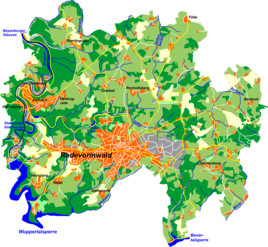Remlingrade
|
Remlingrade
City of Radevormwald
Coordinates: 51 ° 14 ′ 10 ″ N , 7 ° 20 ′ 3 ″ E
|
||
|---|---|---|
| Height : | 300 m above sea level NHN | |
| Residents : | 62 (Oct 31, 2004) | |
| Postal code : | 42477 | |
| Area code : | 02195 | |
|
Location of Remlingrade in Radevormwald |
||
Remlingrade is a place and district of Radevormwald in the Oberbergischer Kreis in the North Rhine-Westphalian administrative district of Cologne in Germany .
Location and description

The place is in the extreme north of the urban area of Radevormwald. The county road 6 connects the site via Önkfeld with Radevormwald and head west with the Wuppertal district Beyenburg . Furthermore, the district road 8 connects the place in the north via the Spreeler Mühle with the Ennepetal district Königsfeld on the federal road 483 . It can be reached from the Wupper town of Dahlerau / Keilbeck via Landesstrasse 130 via Herkingrade. Remlingrade is a location of the Radevormwald volunteer fire brigade . It is curious that the former "Remlingrade" train stop on the Wuppertal Railway and the current bus stop for the 626 bus from Wuppertal to Radevormwald, which is part of the town, is two kilometers away on state road 414 between Beyenburg and Dahlerau .
It is worth mentioning that the small town is the eponymous center of a 700-member Protestant parish, which underlines the regional historical importance of Remlingrade.
The Remlingrader Bach flows past Remlingrade to the south .
history
The place was mentioned for the first time in 1183, namely “ Ritter Udo transfers the abbey to become self-owned of his chapel in Remelinrode as wax interest .” Spelling of the first mention: Remelinrode
Before 1300 Remlingrade became allodial property of the Counts of Berg , who incorporated the hamlet and the surrounding farms as a parish in their Beyenburg office from 1399 .
The church building, which still exists today, was completed in 1745, and construction began in 1743.
In 1815/16 the place had 39 inhabitants. In 1832 the place belonged to the parish Remlingrade of the rural outskirts of the mayor's office Radevormwald . The place, categorized as a church village according to the statistics and topography of the administrative district of Düsseldorf , had a church, a public building, ten residential buildings and three agricultural buildings at that time. At that time, 71 residents lived in the place, eight Catholic and 63 Protestant faith. In 1888, ten houses with 90 inhabitants are listed in the community dictionary of the Rhine Province .
The small town became the scene of a battle between demonstrators who wanted to join the revolution of 1848/1849 and Prussian soldiers in 1849 . Only the support of a local peasant "loyal to the king" could the revolutionaries put to flight.
Sons and daughters of the place
- Johann Peter Plätzer (1782–1846), clockmaker and builder of the church tower clock
- Friedrich Möhler (1887–1963), village schoolmaster and local researcher
- Paul Wellershaus (1887–1976), painter
Hiking and biking trails
The following hiking trails lead through the village:
- The SGV main route "X28" ( Graf-Engelbert-Weg ) from Hattingen to Schladern / Sieg
- The local circular hiking trail "A6"
Individual evidence
- ↑ a b Johann Georg von Viebahn : Statistics and topography of the administrative district of Düsseldorf. Part 2: Containing the statistical table of places and distances and the alphabetical index of place names. Schreiner, Düsseldorf 1836, p. 10 .
- ^ Community encyclopedia for the province of Rhineland. Based on materials from the census of December 1, 1885 and other official sources, edited by the Royal Statistical Bureau. In: Royal Statistical Bureau (Hrsg.): Community encyclopedia for the Kingdom of Prussia. tape XII , 1888, ZDB -ID 1046036-6 ( digitized version ).
Web links
- The battle of Remlingrade on stadtnetz-radevormwald.de
- The history of the village church on inrade.de


